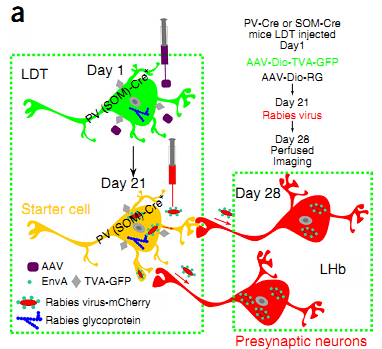AAVs of tracing helper and RV were used for retrograde monosynaptic tracing.
The viruses used in this article are in the table below
|
Tracing Helper |
AAV-CAG-Dio-TVA-eGFP
AAV-CAG-Dio-RG |
|
RV |
RV-EvnA-DsRed |
Hongbin Yang, Junhua Yang, Wang Xi, Sijia Hao, Benyan Luo, Xiaobin He, Liya Zhu, Huifang Lou, Yan-qin Yu, Fuqiang Xu, Shumin Duan & Hao Wang
Pub Date: 2017-01-04,
DOI: 10.1038/nn.4208,
Email: [email protected]
Innate fear has a critical role in survival of animals. Unlike conditioned fear, the neuronal circuitry underlying innate fear is largely unknown. We found that the laterodorsal tegmentum (LDT) and lateral habenula (LHb) are specifically activated by the mouse predator odorant trimethylthiazoline (TMT). Using optogenetics to selectively stimulate GABAergic neurons in the LDT immediately produced fear-like responses (freezing, accelerated heart rate and increased serum corticosterone), whereas prolonged stimulation caused anxiety-like behaviors. Notably, although selective stimulation of parvalbumin (PV)-positive interneurons similarly induced fear-like responses, stimulation of somatostatin-positive interneurons or inhibition of PV neurons in the LDT suppressed TMT-induced fear-like responses without affecting conditioned fear. Finally, activation of LHb glutamatergic inputs to LDT interneurons was sufficient to generate fear-like responses. Thus, the LHb-LDT pathway is important for regulating olfactory cue–induced innate fear. Our results provide a potential target for therapeutic intervention for anxiety disorder.
 Figure 1. Schematic diagram of LDT injection of AAV-CAG-Dio-TVA-eGFP (AAV2/9) virus and AAV-CAG-Dio-RG (AAV2/9) on day 1 and RV-EvnA-DsRed on day 21 in SOM-Cre or PV-Cre mice to retrogradely trace the input neurons (red) to LDT interneurons (yellow, starter neurons).
Figure 1. Schematic diagram of LDT injection of AAV-CAG-Dio-TVA-eGFP (AAV2/9) virus and AAV-CAG-Dio-RG (AAV2/9) on day 1 and RV-EvnA-DsRed on day 21 in SOM-Cre or PV-Cre mice to retrogradely trace the input neurons (red) to LDT interneurons (yellow, starter neurons).
This study is aimed to explore the neuronal circuitry underlying innate fear. Combining in vivo optogenetic manipulations, behavioral assays and synaptic electrophysiology, the authors were able to identify the LDT as the key component in the brain for regulating olfactory cue–induced innate fear. The results provide a potential target for therapeutic intervention for anxiety disorder.
BrainVTA offers viral vector construction & virus packaging services for AAV, LV, RABV, PRV, HSV and VSV that help researchers explore questions about genes, neurons, circuitry structure, function of brain network, mechanism and treatment of diseases.
If you have any needs, just email us at
[email protected].
